Samsung Galaxy Note 2 Review (T-Mobile) - The Phablet Returns
by Brian Klug on October 24, 2012 9:00 AM ESTThe original generation Galaxy Note I played with was an AT&T model, and as a result was based around the same platform (I call a platform the combination of SoC and baseband) as the Skyrocket, which was AT&T’s SGS2 with LTE. That platform was Qualcomm’s Fusion 2 chipset, the very popular combination of a APQ8060 SoC (45nm dual core Scorpion at 1.5 GHz with Adreno 220 graphics) and MDM9x00 for baseband (Qualcomm’s 45nm first generation multimode LTE solution). The US-bound Galaxy S 3 variants were built around the successor of that platform, which was Qualcomm’s MSM8960 SoC (28nm dual core Krait at 1.5 GHz with Adreno 225 graphics and an onboard 2nd gen LTE baseband). The result was quick time to market with the latest and greatest silicon, improvements to performance, onboard LTE without two modems, and lower power consumption.

The Galaxy Note 2 does something different, and finally brings Samsung’s Exynos line of SoCs into devices bound for the USA where air interfaces are a combination of LTE, WCDMA, and CDMA2000. It’s clear that the Note 2 was on a different development cycle, and this time the standalone 28nm LTE baseband I’ve been talking about forever was available for use in the Galaxy Note 2, that part is MDM9x15, same as what’s in the iPhone 5, Optimus G, One X+, and a bunch of other upcoming handsets. If you haven’t read our other reviews where I’ve talked about this, the reason is that MDM9x15 is now natively voice enabled (MDM9x00 was not unless you ran with a Fusion platform), smaller, and lower power than its predecessor. The result is that there’s finally a multimode FDD-LTE, TDD-LTE, WCDMA (up to DC-HSPA+), EVDO (up to EVDO Rev.B) and TD-SCDMA baseband out there which doesn’t require going with a two chip solution. I could go on for pages about how this is primarily an engineering decision at this point, but the availability of MDM9x15 is why we see OEMs starting to finally ship handsets based around SoCs other than Qualcomm’s and also include LTE at the same time.
Anyhow, for a lot of people this will be the first time experiencing Samsung’s own current Exynos 4 flagship, Exynos 4412, which is of course quad core ARM Cortex A9s at a maximum of 1.6 GHz alongside ARM Mali–400MP4 built on Samsung’s 32nm HK-MG process. To the best of my knowledge, the Note 2 continues to use a 2x32 bit LPDDR2 memory interface, same as the international Galaxy S 3, though PCDDR3 is also a choice for Exynos 4412.
I’ve put together a table with specifications of the Note 2 and some other recent devices for comparison.
| Physical Comparison | ||||
| Apple iPhone 5 | Samsung Galaxy S 3 (USA) | Samsung Galaxy Note (USA) | Samsung Galaxy Note 2 | |
| Height | 123.8 mm (4.87") | 136.6 mm (5.38" ) | 146.8 mm | 151.1 mm |
| Width | 58.6 mm (2.31") | 70.6 mm (2.78") | 82.9 mm | 80.5 mm |
| Depth | 7.6 mm (0.30") | 8.6 mm (0.34") | 9.7 mm | 9.4 mm |
| Weight | 112 g (3.95 oz) | 133g (4.7 oz) | 178 g | 180 g |
| CPU | 1.3 GHz Apple A6 (Dual Core Apple Swift) | 1.5 GHz MSM8960 (Dual Core Krait) | 1.5 GHz APQ8060 (Dual Core Scorpion) | 1.6 GHz Samsung Exynos 4412 (Quad Core Cortex A9) |
| GPU | PowerVR SGX 543MP3 | Adreno 225 | Adreno 220 | Mali-400MP4 |
| RAM | 1 GB LPDDR2 | 2 GB LPDDR2 | 1 GB LPDDR2 | 2 GB LPDDR2 |
| NAND | 16, 32, or 64 GB integrated | 16/32 GB NAND with up to 64 GB microSDXC | 16 GB NAND with up to 32 GB microSD | 16/32/64 GB NAND (?) with up to 64 GB microSDXC |
| Camera | 8 MP with LED Flash + 1.2MP front facing | 8 MP with LED Flash + 1.9 MP front facing | 8 MP with LED Flash + 2 MP front facing | 8 MP with LED Flash + 1.9 MP front facing |
| Screen | 4" 1136 x 960 LED backlit LCD | 4.8" 1280x720 HD SAMOLED | 5.3" 1280 x 800 HD SAMOLED | 5.5" 1280 x 720 HD SAMOLED |
| Battery | Internal 5.45 Whr | Removable 7.98 Whr | Removable 9.25 Whr | Removable 11.78 Whr |
The Galaxy Note 2 also is one of the first handsets on the market other than Nexus devices to ship running Android 4.1. This puts it at a definite advantage in some tests as we’ll show in a moment, both due to improvements from project butter and what appear to be even newer Mali–400 drivers. I pulled the Note 1 out of my drawer and updated it to Android 4.0.1 and ran all the same tests again.
First up are some of the usual JavaScript performance tests which are run in the stock browser. Anand added a few in, and personally I think we’ve got almost an abundance of JavaScript performance emphasis right now. Again this is strongly influenced by the V8 JIT (Just In Time Compilation) library bundled with the stock browser on Android. OEMs spend a lot of time here optimizing V8 to the nuances of their particular architecture which can make a substantial difference in scores.
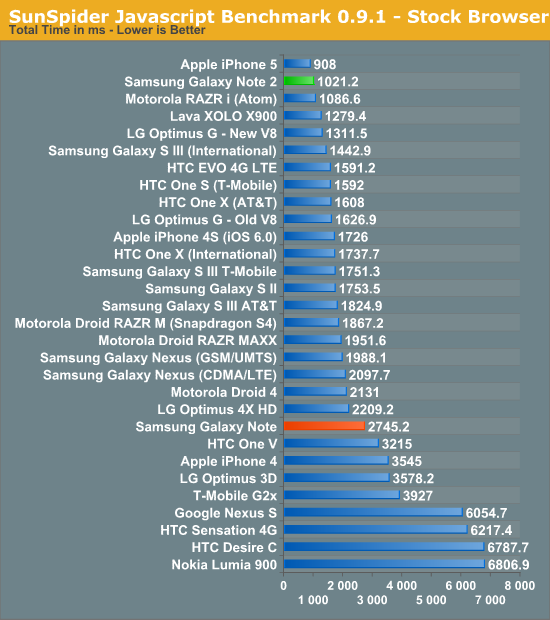

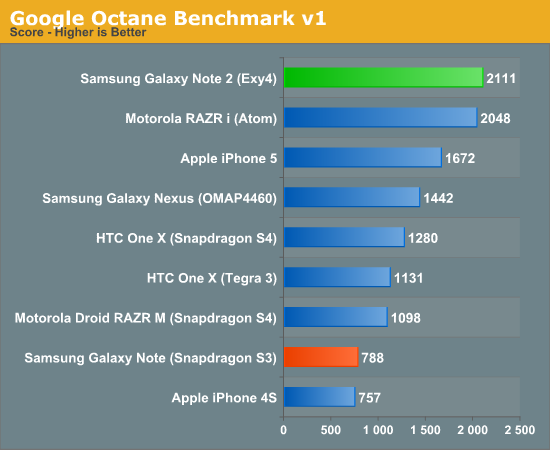
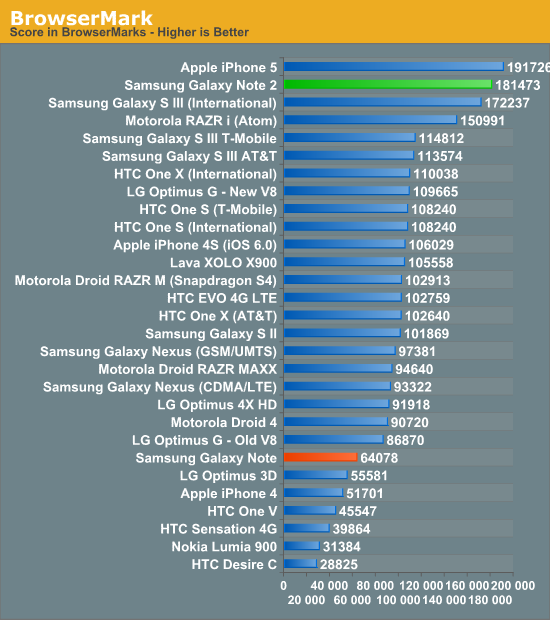
The usual disclosure here is that Android benchmarking is still a non-deterministic beast due to garbage collection, and I’m still not fully satisfied with everything that is available out there, but we have to make do with what we’ve got for the moment.
Next up is GLBenchmark 2.5.1 which now includes a beefier gameplay simulation test called Egypt HD alongside the previous Egypt test which is now named Egypt Classic. Offscreen resolution gets a bump to 1080p as well.
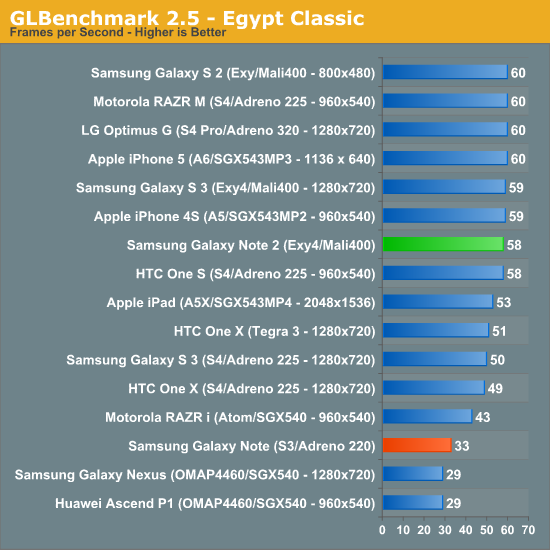
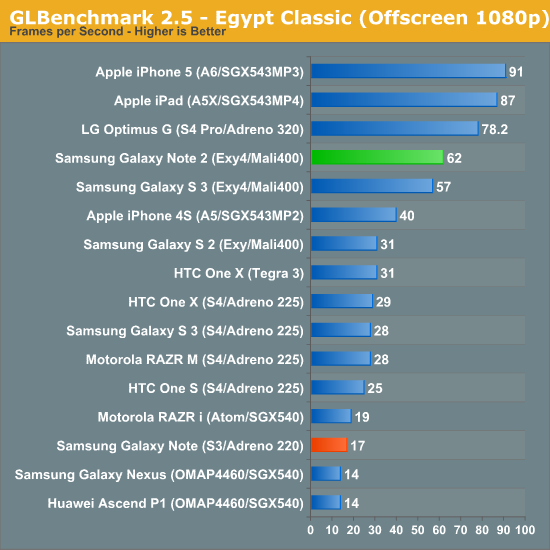
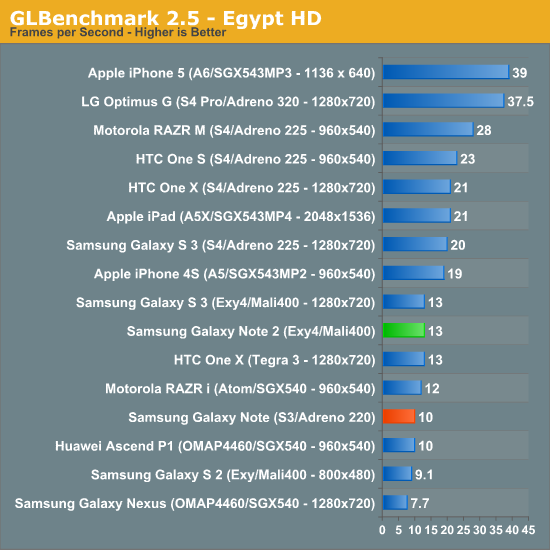
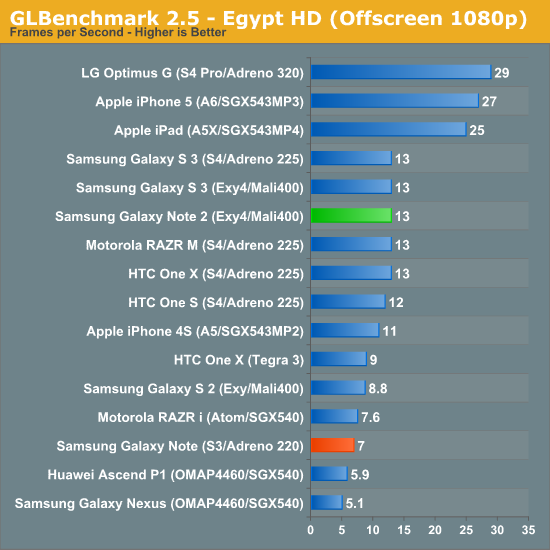
Here we see Mali–400 MP4 performing basically the same as I saw in the International Galaxy S 3 which is no surprise — it is after all the same SoC. Other than a slight bump in the Egypt Classic offscreen performance numbers, there aren’t any surprises. We see Exynos 4412 putting up a good fight, but Adreno 320 in APQ8064 is still something to look out for on the horizon. I'd run Taiji as well but we'd basically just see vsync at this point.
Vellamo 2.0.1 is a new version of the previously well-received Vellamo test developed by Qualcomm initially for in-house performance regression testing and checkin, later adopted by OEMs for their own testing, and finally released onto the Google Play Store. This is the first time the 2.0 version of Vellamo has made an appearance here, and after vetting it and spending time on the phone with its makers I feel just the same way about 2.0 as I did 1.0. There’s still the disclosure that this is Qualcomm’s benchmark, and that stigma will only go away after the app is open sourced for myself and others to code review, but from what deconstruction of the APK I’ve done, and further inspection of the included jS, I’m confident there’s no blatant cheating going on, it isn’t worth it.
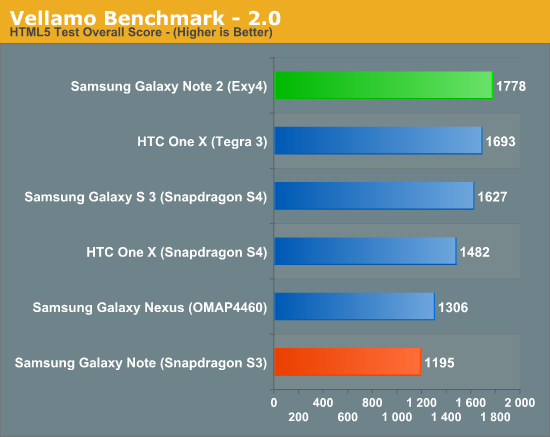
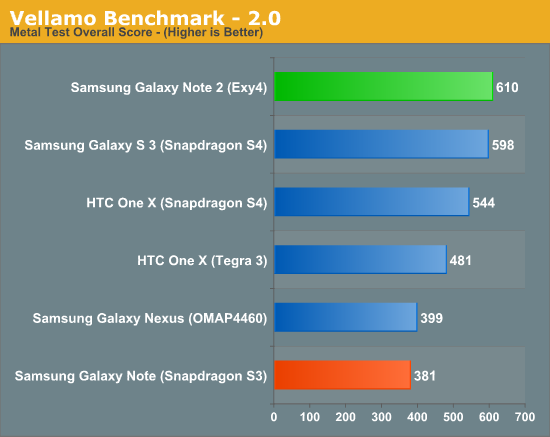
Vellamo 2’s biggest new thing is the inclusion of a new ‘metal’ test which, as the name implies, includes some native tests. This is C code compiled with just the standard android compiler and -o2 optimization flag into both ARMv7 and x86 code. There’s Dhrystone for integer benchmarking, Linpack (native), Branch-K, Stream 5.9, RamJam, and a storage subtest.
Exynos 4412 and Android 4.1 is definitely a potent combination, which puts it close to the top if not at the top in a ton of CPU bound tests. My go-to application with lots of threading is still Chrome for Android, which regularly lights up four core devices completely. Even though our testing is done in the stock browser (since this almost always has the faster, platform-specific V8 library) my subjective tests are in Chrome, and the Note 2 feels very quick.










131 Comments
View All Comments
djpavcy - Thursday, October 25, 2012 - link
Brian, as others have pointed out there must be something wrong with your battery tests. All the other reviews on the net show much better performance than what you see which makes sense - this phone has a quite large battery. Maybe you have a defective unit?Vinas - Thursday, October 25, 2012 - link
There's a reason ford put a rubber tray on the dash - it's for your GN2! At least that's where I put mine while I drive (until I buy a dash mount for it). The GN2 is a bad ass phone, and maybe the novelty of the device has not worn off yet (got it yesterday at release) but I mean, there is something to be said for having the world's most powerful smartphone in your hands! haha eat it suckerskhanikun - Friday, October 26, 2012 - link
I was probably one of the few thousands of ppl who bought the Dell 5" Streak when they first came out and gigantic phones....not all that great. I got away from them, only for a bajillion other phones to get big.fate_accompli - Friday, October 26, 2012 - link
Well, thanks for that, Dr. Freud.In my own case, I'm getting the Note 2 because IT TAKES NOTES!!
Imagine that !? One of the things it was designed for! The big screen
also makes it easier to stab icons with my bigass finger. Also, movies
look cooler with bigger screens- it's why people buy bigger screens for
their home theaters...same principle.
Nothing subconscious about it. Otherwise, a very nice review.
CeriseCogburn - Friday, February 1, 2013 - link
Exactly, it fits the small package, big guns, PC insanity clack, which of course every idiot spews incessantly, ignoring the other reality that actually is a fact that the big gun in the big bad ghetto everywhere is toted by the big black packaged...So much for the small minded retards parading around as the cultural elite minded peak of our society.
jwhyrock - Saturday, October 27, 2012 - link
I know I'm going to enjoy using the Note 2 more than a smaller device which is the primary concern for me. I currently have the Samsung Vibrant (Galaxy S1) so I'm going to see a huge performance increase just having current technology.I'm not g33k enough to fully wrap my head around each test that was run. I did see a pattern of the iphone 5 and Droid beating out other phones in the testing. I intensely dislike Apple as a company and find the iphone on the whole to be uninspiring.
Winning on some of the benchmarks isn't going to persuade me to ditch the Note 2.
I wonder if the author or anyone else can put in perspective the overall performance between Note 2 and higher performing devices. Is it a noticeable or just a benchmark number?
Anon - Sunday, October 28, 2012 - link
Why oh why it's always missing the audio chip report? I need to know whether the US version will retain the Wolfson chip .hemanthj - Monday, October 29, 2012 - link
If I would buy the USA version of Note 2. Will I be able to use the LTE outside US in Asia and Europe. Or I need to buy the Note 2 International version for that.bellasys - Wednesday, October 31, 2012 - link
While T-Mobile is not generally considered primo, I had the opportunity to understand just how fine their network was while supporting network services for AT&T during the Cingular merger. At that time, our company had a division which provided similar services for T-Mobile, and I got the inside track from my buddies.So, I really respect the author giving credit where it's due, and writing about a feature such as DC-HSPA+ which techs like me might care about. It reminds me of T-1 modem bonding before Y2K. Big kudos on this point.
Although I can't say this one feature would be enough to make me switch- no single carrier can do it all.
Great and informative article. Thanks :)
garrun - Friday, November 2, 2012 - link
I have a Samsung GS3 and have been pretty unhappy with it for one, annoying reason. When I use it in my car (Infiniti G37, but I've heard the same problem exists in others, including Ford Sync) I have two problems. First, if bluetooth is enabled, it takes preference for audio input, such that I can't use S-Voice (S3's SIri equivalent) to send text, plays songs, use maps... anything). My car doesn't support music over bluetooth, so I plug in to the headphone jack when listening to books or music. When THAT happens, the line out trumps the bluetooth for audio priority, and I can't even use bluetooth for phone calls. The net effect is that I can't use voice commands while driving at all, unless I unplug the line out and disable BT. The other effect is that if I am listening to music or books, and I get a call, I have to reach over and yank out the audio cable in order to take the call. I had to buy off contract, so I paid about $600 for this thing, and these are not problems I've had with my previous Android phones or with iPhones, and I don't understand why I didn't see them mentioned in any reviews.This all brings me to my point here - I'm thinking of selling my GS3 and getting a Note 2 or maybe an HTC 8X - can anyone here or at Anand confirm if these problems exist in those devices? Does anyone else share my pain with the GS3? Why is this not a bigger deal in the tech media?